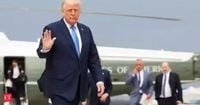In a bold move aimed at reshaping international trade dynamics, U.S. President Donald Trump has announced a sweeping tariff plan, set to be unveiled on April 2, 2025, which he has dubbed "Liberation Day." This initiative comes as part of his strategy to impose reciprocal tariffs on countries that levy fees on American exports. Trump has already implemented tariffs on aluminum, steel, and automobiles, alongside increased duties on all imports from China, emphasizing his administration's focus on addressing trade imbalances.
During a recent press briefing aboard Air Force One, Trump stated, "You'd start with all countries," dismissing speculation that the tariffs would target only a select few nations. He reiterated that the administration aims to focus on 10 to 15 countries with the most significant trade imbalances, according to White House economics adviser Kevin Hassett.
In an effort to strengthen trade ties, India is reportedly considering reducing or even eliminating customs duties on auto parts imported from the U.S. However, this potential shift comes amidst escalating tensions in U.S.-India trade relations, as Trump has branded India a "tariff king" and a "big abuser" of trade practices. The U.S. has long sought greater access to India's agricultural market, which remains heavily protected by high tariffs.
As Trump prepares to roll out his new tariff measures, he has signaled a willingness to negotiate better trade terms. "We’re going to charge countries for doing business in our country and taking our jobs, taking our wealth," he stated. The reciprocal tariffs are designed to match the rates charged by other nations, accounting for subsidies and non-tariff barriers.
Despite these aggressive tactics, concerns are mounting regarding the potential impact of tariffs on American consumers. Trump has dismissed worries that higher tariffs could drive up vehicle prices, arguing that increased costs on foreign cars would boost sales of American-made vehicles. "I hope they raise their prices, because if they do, people are gonna buy American-made cars," he remarked during an interview with NBC News.
Moreover, the administration is preparing to impose additional tariffs on imported pharmaceutical drugs, copper, and lumber, while also targeting countries that import oil from Venezuela. Imports from China are now subject to a 20% tariff due to its role in fentanyl production, and the existing steel and aluminum tariffs have been expanded to 25% on all imports.
As the U.S. navigates these complex trade negotiations, the agricultural sector has emerged as a critical battleground. U.S. Commerce Secretary Howard Lutnick has criticized India's trade policies, claiming that the country blocks U.S. farmers from accessing its agricultural market. He urged India to open its market further, suggesting that it should consider quotas or limits on imports.
India's agricultural landscape is characterized by a high degree of protectionism, with tariffs ranging from zero to 150% on farm imports. The weighted average tariff for U.S. farm products entering India stands at 37.7%, in stark contrast to the mere 5.3% average tariff on Indian goods entering the U.S. This disparity highlights the challenges faced by U.S. farmers seeking to penetrate the Indian market.
Despite being a food surplus nation, India has maintained these high tariffs to shield its farmers from cheaper imports. Agricultural employment remains a significant part of India's economy, with nearly half of the workforce engaged in farming, yet it only accounts for 15% of the country's GDP. This structural imbalance complicates trade negotiations as India seeks to protect the livelihoods of millions of small farmers.
As both countries prepare for upcoming negotiations, the U.S. aims to finalize the first phase of a bilateral trade agreement by fall 2025, with a goal of more than doubling bilateral trade to USD 500 billion by 2030. The U.S. has requested duty concessions in sectors such as automobiles, dairy, and agricultural products, while India is likely to push for reductions in labor-intensive industries like textiles.
Experts warn that India's agricultural challenges extend beyond external pressures. The sector has long been underfunded, receiving less than 6% of total investment, which has hindered its growth and productivity. India's transformation from a food-deficient nation to a food-surplus powerhouse is a significant achievement, yet it still faces issues like low crop yields and inadequate infrastructure.
In light of these complexities, experts advise India to maintain a strong negotiating position. Ajay Srivastava of the Global Trade Research Initiative cautioned against yielding to U.S. pressure to open its agricultural sector, warning that it could disrupt millions of livelihoods and threaten food security. He emphasized that India must prioritize its national interests and protect its rural economy.
As the deadline for tariff implementation approaches, the stakes are high for both nations. India must navigate its agricultural policies carefully, balancing the demands of the U.S. with the needs of its farmers. The success of these negotiations will ultimately depend on India's ability to assert its priorities while engaging with U.S. interests.
In the broader context of global trade, the upcoming tariffs represent a pivotal moment in U.S.-India relations. As both countries grapple with the implications of these policies, the outcome will shape not only their economic futures but also the dynamics of international trade.






